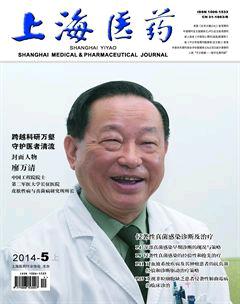侵袭性真菌感染的经验性和抢先治疗
刘正印
摘 要 侵袭性真菌感染(invasive fungal infection, IFI)更趋常见,其原因除广谱抗生素的应用以及肿瘤放疗和化疗、造血干细胞移植、器官移植和免疫功能缺陷患者增多等外,最主要的是新的诊断真菌感染的临床实验室技术、尤其是半乳甘露聚糖试验和(1,3)-β-D-葡聚糖试验的应用逐渐普及,为临床诊断IFI提供了坚实的基础。此外,IFI的影像学特征也成为诊断IFI的一个重要条件。与经验性抗真菌治疗相比,这些实验室和影像学检查的阳性结果可提高诊断的可靠性,由此为真菌感染治疗提供更多的依据,同时减少抗真菌药物的滥用。
关键词 侵袭性真菌感染 经验性治疗 抢先治疗
中图分类号:R519; R44 文献标识码:A 文章编号:1006-1533(2014)09-0008-03
Abstract Due to the use of broad-spectrum antibiotics and the increasing number of the immune-incompetent patients who received tumor radiotherapy and chemotherapy, hematopoietic stem cell transplantation, organ transplantation as well as immunosuppressive therapy, the incidence of invasive fungal infection (IFI) has been gradually increased. Another more important cause was the improvement of the laboratory and imaging diagnosis technology, especially (1,3)-β-D-glucan test and galactomannan test, which provide solid basis for clinical diagnosis of IFI so as to increase the diagnostic rate. Compared with empirical anti-fungal therapy, these positive results from the laboratory assay and imaging examination can increase the reliability of the diagnosis of IFI and provide more evidence for the treatment of IFI, and meanwhile reduce the abuse of antifungal agents.
Key wordS invasive fungal infection; empirical therapy; preemptive antifungal therapy
试验以及对某些真菌的聚合酶链反应(polymerase chain reaction, PCR)等一些新技术的发展为临床IFD的诊治带来了新的曙光,也使经验性治疗转化为抢先治疗更为可靠,可减少治疗的盲目性。
1)血清学诊断方法
指利用免疫和生化方法检测血清或其他体液中真菌细胞壁和胞质抗原以用于诊断IFI的方法,临床上常用的有诊断隐球菌脑膜炎和播散性组织胞浆菌病的新型隐球菌和荚膜组织胞浆菌的荚膜抗原检测等,近年来最有价值的为GM和G试验。
(1)GM试验
GM是曲霉细胞壁的特异性多糖成分,其水平一般在感染的早期或发病5 ~ 8 d后开始升高,动态监测具有早期诊断和判断疗效的价值。对侵袭性曲霉病患者可采取血液、支气管肺泡灌洗液或脑脊液等标本检测,诊断阈值通常为0.5。但不同的研究给出的阈值不同,故敏感性和特异性也不相同[3]。一项荟萃分析表明,GM试验对确诊病例的敏感性为71%、特异性为89%,对确诊和临床诊断病例的总敏感性和特异性分别为61%和93%,阳性和阴性预测值分别为26% ~ 53%和95% ~ 98%[4]。对有不同基础疾病的患者,GM试验的敏感性和特异性也有较大的差别,如对血液系统肿瘤患者的敏感性和特异性分别为70%和92%、对骨髓造血干细胞移植患者的敏感性和特异性分别为82%和86%,但对实体器官移植患者的敏感性和特异性分别为22%和84%。连续2次以上阳性结果的特异性高,即动态监测对诊断和疗效判断的价值更大。GM试验受到真菌感染部位、真菌释放出GM的量、使用抗真菌药物和食用大豆类食物等因素的影响,使用哌拉西林-他唑巴坦或阿莫西林-克拉维酸治疗的患者也可能出现假阳性。
(2)G试验
G为真菌细胞壁成分,血浆G水平升高是IFI的重要标志。除接合菌和隐球菌外,念珠菌属、曲霉属、毛孢子属、镰刀属、枝顶孢属和酵母属等真菌的细胞壁中都含有G。G也能以支气管肺泡灌洗液或脑脊液进行检测,试验的敏感性为76.8%、特异性为85.3%。由于不同研究采用的界限值不同,G试验的敏感性和特异性差别较大,分别为67% ~ 100%和70% ~ 96%[5-6]。G试验阳性只能确定可能有IFI,但对诊断是何种真菌感染则无特异性,故还需结合微生物直接镜检或培养鉴定真菌的属和种。G试验受真菌G的含量和其他条件的影响,如手术中使用纱布、输注白蛋白或球蛋白、血液透析或输注多糖类抗肿瘤药物都可导致出现假阳性。G试验尚未在实体器官移植和儿童患者中进行过客观评价。
如能排除影响敏感性和阴性预测值的因素,GM试验和G试验联合检测侵袭性曲霉感染的特异性可达100%、阳性预测值为100%。根据不同真菌所含细胞壁成分的不同,还能依GM试验和G试验结果判断感染真菌的种属。
2)影像学检查
影像学检查对早期诊断IFD很有帮助,尤其是近年来高分辨力CT的应用为早期诊断免疫功能缺陷患者的侵袭性肺部真菌感染提供了必要的手段。IFI患者的肺部通常有结节样团块影、实变、梗死形状的结节、空洞、晕环征和空泡新月征,而晕环征和空泡新月征往往是侵袭性肺部曲霉病的特征性改变,出现晕环征的患者对抗真菌治疗的反应明显好于无晕环征患者[7]。
3)核酸检测技术
对临床标本进行真菌核酸检测、尤其是基于PCR扩增技术的检测被认为是诊断IFI非常有效的方法。普通的PCR方法易被污染、假阳性率高且无法区别是定植还是感染,故目前研究较多的是实时PCR技术,后者能对念珠菌属精确鉴定到种并可定量检测,速度快、被污染的几率低。但PCR方法因敏感性过高、容易出现假阳性,同时检测方法也未标准化,故现尚未被接受用作IFI的诊断依据。目前有许多用来早期诊断曲霉感染的基于PCR的方法,但由于它们所采用的核酸提取物、引物和探针不同,进行PCR反应的条件也不同,所以很难得出固定的结论。对合计包括1 618例高危患者的16项研究的荟萃分析表明,对确诊或临床诊断患者,无论采用全血还是血清或血浆中的曲霉DNA,检测的敏感性和特异性分,2次或更多次连续的PCR检测的敏感性和特异性分别为75%和87%[8]。同样,在Barnes等[9]对有曲霉感染高危因素的125例患者进行的一项前瞻性研究中,1次和2次或更多次PCR检测的确诊的敏感性分别为,特异性高达98%。根据阳性结果采取抢先治疗的策略能大大减少抗真菌药物的使用。
既然影像学、G试验、GM试验和真菌核酸PCR检测对IFI的抢先治疗都有着重要的指导意义,那么是否结合使用上述检测方法就可减少假阳性率和提高确诊率、由此增加抢先治疗而减少因经验性治疗所致抗真菌药物的使用呢?Barnes等[9]探讨了结合使用PCR检测和GM试验诊断IFI的敏感性和特异性,发现两者同时阳性时的敏感性和特异性分别达87.5%和100%。结合使用GM试验和高分辨力CT检查对有IFI高危因素的血液疾病患者进行前瞻性研究,发现在117例有中性粒细胞减少伴发热的患者中,原至少有41例(35%)符合经验性抗真菌治疗标准,但结合使用GM试验和高分辨力CT检查后只有9例(7.7%)给予了抗真菌治疗[10]。抢先治疗是建立在如GM试验或胸部高分辨力CT检查等基础上的,建立在结合使用这些方法基础上的抢先治疗可明显减少抗真菌药物的使用、节省医疗资源。
有研究证实,与经验性治疗相比,抢先治疗虽使IFI的发生率明显增加,但在生存率上却没有明显差别(中性粒细胞减少伴持续或反复发热患者的生存率在经验性治疗和抢先治疗,而抗真菌药物使用明显减少[11]。也就是说,在真菌感染治疗的疗效上,抢先治疗并不优于经验性治疗
总之,在IFI的分级诊断和分阶梯治疗中,并没有足够的证据证明经验性治疗和抢先治疗的策略孰优孰劣,但抢先治疗可减少治疗的盲目性、节省医疗资源和减少抗真菌药物的使用。因此,在临床上如何处理经验性治疗和抢先治疗之间的关系,这是每一个治疗方案制定者都应认真思考的一个问题。
参考文献
[1] Pfaller MA, Pappas PG, Wingard JR, et al. Invasive fungal pathogens: current epidemiological trend [J]. Clin Infect Dis, 2006, 43(suppl 1): S3-S14.
[2] de Pauw B, Walsh TJ, Donnelly JP, et al. Revised definitions of invasive fungal disease from the European Organization for Research and Treatment of Cancer/Invasive Fungal Infections Cooperative Group and the National Institute of Allergy and Infectious Diseases Mycoses Study Group (EORTC/MSG) Consensus Group [J]. Clin Infect Dis, 2008, 46(12): 1813-1821.
[3] Leeflang MM, Debets-Ossenkopp YJ, Visser CE, et al. Galactomannan detection for invasive aspergillosis in immunocompromized patients [J/OL]. Cochrane Database Syst Rev, 2008(4): CD007394 [2008-12-05]. http://onlinelibrary.wiley.com/doi/10.1002/14651858.CD007394/pdf.
[4] Pfeiffer CD, Fine JP, Safdar N, et al. Diagnosis of invasive aspergillosis using a galactomannan assay: a meta-analysis [J]. Clin Infect Dis, 2006, 42(10): 1417-1427.
[5] Karageorgopoulos DE, Vouloumanou EK, Ntziora F, et al. β-D-glucan assay for the diagnosis of invasive fungal infections: a meta-analysis [J]. Clin Infect Dis, 2011, 52(6): 750-770.
[6] Ostrosky-Zeichner L, Alexander BD, Kett DH, et al. Multicenter clinical evaluation of the (1-3)-β-D-glucan assay as an aid to diagnosis of fungal infections in humans [J]. Clin Infect Dis, 2005, 41(5): 654-659.
[7] Greene RE, Schlamm HT, Oestmann JW, et al. Imaging findings in acute invasive pulmonary aspergillosis: clinical significance of the halo sign [J]. Clin Infect Dis, 2007, 44(3): 373-379.
[8] Mengoli C, Cruciani M, Barnes RA, et al. Use of real-time PCR for diagnosis of invasive aspergillosis: systemic review and meta-analysis [J]. Lancet Infect Dis, 2009, 9(5): 89-96.
[9] Barnes RA, White PL, Bygrave C, et al. Clinical impact of enhanced diagnosis of invasive fungal disease in high-risk haematology and stem cell transplant patients [J]. J Clin Pathol, 2009, 62(1): 64-69.
[10] Maertens J, Theunissen K, Verhoef G, et al. Galactomannan and computed tomography-based preemptive antifungal therapy in neutropenic patients at high risk for invasive fungal infection: a prospective feasibility study [J]. Clin Infect Dis, 2005, 41(9): 1242-1250.
[11] Cordonnier C, Pautas C, Maury S, et al. Empirical versus preemptive antifungal therapy for high-risk, febrile, neutropenic patients: a randomized, controlled trial [J]. Clin Infect Dis, 2009, 48(8): 1042-1051.
(收稿日期:2013-09-05)
[6] Ostrosky-Zeichner L, Alexander BD, Kett DH, et al. Multicenter clinical evaluation of the (1-3)-β-D-glucan assay as an aid to diagnosis of fungal infections in humans [J]. Clin Infect Dis, 2005, 41(5): 654-659.
[7] Greene RE, Schlamm HT, Oestmann JW, et al. Imaging findings in acute invasive pulmonary aspergillosis: clinical significance of the halo sign [J]. Clin Infect Dis, 2007, 44(3): 373-379.
[8] Mengoli C, Cruciani M, Barnes RA, et al. Use of real-time PCR for diagnosis of invasive aspergillosis: systemic review and meta-analysis [J]. Lancet Infect Dis, 2009, 9(5): 89-96.
[9] Barnes RA, White PL, Bygrave C, et al. Clinical impact of enhanced diagnosis of invasive fungal disease in high-risk haematology and stem cell transplant patients [J]. J Clin Pathol, 2009, 62(1): 64-69.
[10] Maertens J, Theunissen K, Verhoef G, et al. Galactomannan and computed tomography-based preemptive antifungal therapy in neutropenic patients at high risk for invasive fungal infection: a prospective feasibility study [J]. Clin Infect Dis, 2005, 41(9): 1242-1250.
[11] Cordonnier C, Pautas C, Maury S, et al. Empirical versus preemptive antifungal therapy for high-risk, febrile, neutropenic patients: a randomized, controlled trial [J]. Clin Infect Dis, 2009, 48(8): 1042-1051.
(收稿日期:2013-09-05)
[6] Ostrosky-Zeichner L, Alexander BD, Kett DH, et al. Multicenter clinical evaluation of the (1-3)-β-D-glucan assay as an aid to diagnosis of fungal infections in humans [J]. Clin Infect Dis, 2005, 41(5): 654-659.
[7] Greene RE, Schlamm HT, Oestmann JW, et al. Imaging findings in acute invasive pulmonary aspergillosis: clinical significance of the halo sign [J]. Clin Infect Dis, 2007, 44(3): 373-379.
[8] Mengoli C, Cruciani M, Barnes RA, et al. Use of real-time PCR for diagnosis of invasive aspergillosis: systemic review and meta-analysis [J]. Lancet Infect Dis, 2009, 9(5): 89-96.
[9] Barnes RA, White PL, Bygrave C, et al. Clinical impact of enhanced diagnosis of invasive fungal disease in high-risk haematology and stem cell transplant patients [J]. J Clin Pathol, 2009, 62(1): 64-69.
[10] Maertens J, Theunissen K, Verhoef G, et al. Galactomannan and computed tomography-based preemptive antifungal therapy in neutropenic patients at high risk for invasive fungal infection: a prospective feasibility study [J]. Clin Infect Dis, 2005, 41(9): 1242-1250.
[11] Cordonnier C, Pautas C, Maury S, et al. Empirical versus preemptive antifungal therapy for high-risk, febrile, neutropenic patients: a randomized, controlled trial [J]. Clin Infect Dis, 2009, 48(8): 1042-1051.
(收稿日期:2013-09-05)

